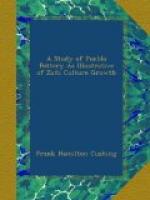[Illustration: FIG. 547.—Conical or flat-bellied canteen.]
It is natural for the Pueblo to consider water as the prime source of life, or as accompanied by it, for without the presence of living water very few things grow in his desert land. During many a drought chronicled in his oral annals, plants, animals, and men have died as of a contagious scourge. Naturally, therefore, he has come to regard water as the milk of adults, to speak of it as such, and as the all-sufficient nourishment which the earth (in his conception of it as the mother of men) yields. In the times when his was a race of cliff and mesa dwellers, the most common vessel appertaining to his daily life was the flat-bellied canteen or water-carrier. (See Fig. 547.) This was suspended by a band across the forehead, so as to hang against the back, thus leaving the hands as well as the feet free for assistance in climbing. It now survives only for use on long journeys or at camps distant from water. The original suggestion of its form seems to have been that of the human mammary gland, or perhaps its peculiar form may have suggested a relationship between the two. (Compare Figs. 548, 549.) At any rate, its name in Zuni is me’ he ton ne, while me’ ha na is the name of the human mammary gland. Me’ he ton ne is from me’ ha na, mamma, e’ ton nai e, containing within, and to’m me. From me’ ha na comes wo’ ha na, hanging or placed against anything, obviously because the mammaries hang or are placed against the breast; or, possibly, me ha na may be derived from wo ha na by a reversal of reasoning, which view does not affect the argument in question. It is probable that the me’ he ton was at first left open at the apex (Fig. 549._a_) instead of at the top (Fig. 549._b_); but, being found liable to leak when furnished with the aperture so low, this was closed. A surviving superstition inclines me to this view. When a Zuni woman has completed the me’ he ton nearly to the apex, by the coiling-process, and before she has inserted the nozzle (Fig. 549._b_), she prepares a little wedge of clay, and, as she closes the apex with it, she turns her eyes away. If you ask her why she does this, she will tell you that it is a’k ta ni (fearful) to look at the vessel while closing it at this point; that, if she look at it during this operation, she will be liable to become barren; or that, if children be born to her, they will die during infancy; or that she




